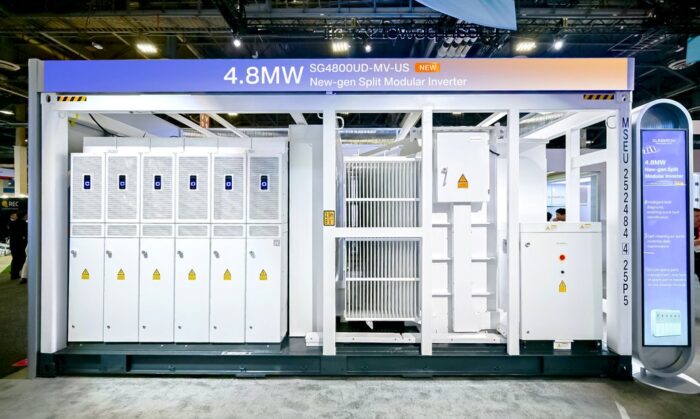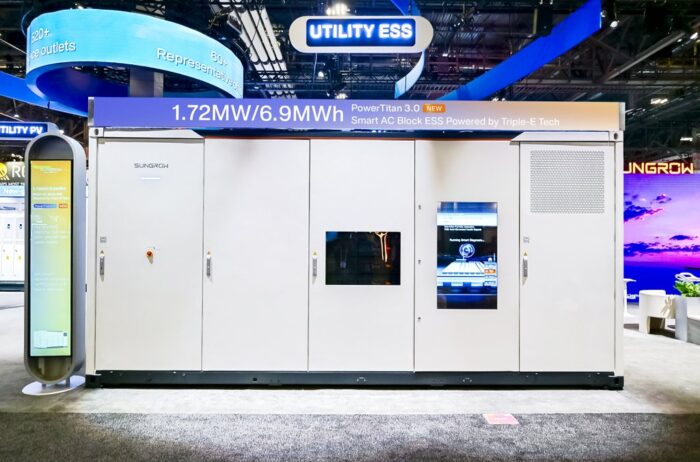Sungrow explains next-gen inverters, BESS, and meeting data center demand
At RE+, Sungrow introduced a 4.8 MW modular inverter, the PowerTitan 3.0 AC Block energy storage system, and the PowerStack 255CS for C&I projects—highlighting grid-forming capabilities, liquid-cooled reliability, and new options for data centers

Sungrow used RE+ 2025 in Las Vegas to showcase a trio of products aimed squarely at the North American market: a 4.8 MW modular inverter for utility-scale PV, the next-generation PowerTitan 3.0 AC Block energy storage system, and the PowerStack 255CS designed for commercial and industrial (C&I) applications.
The common thread across all three is a focus on efficiency, reliability, and the flexibility to meet different project classes, from large solar fields to critical-load data centers.
4.8 MW modular inverter
At the top of the solar release slate was the SG4800UD-MV-US, a second-generation modular inverter rated at 4.8 MW (pictured atop this post). The design combines attributes of both central and string inverters, with 800 kW building blocks that allow replacements in less than an hour. The split-module approach simplifies spare parts management—only one type of module is needed—and reduces downtime during service.
Durability is a key spec: the system can deliver full power output in ambient temperatures up to 45 °C (113 °F), carries a NEMA 4X rating, and integrates self-cleaning air ducts for lower daily maintenance needs. Additional safety features include smart DC terminal temperature protection and a bottom pressure relief design. Sungrow also built in PV grid-forming and off-grid commissioning capabilities to allow earlier commercial operation.
PowerTitan 3.0: AC Block BESS

The PowerTitan 3.0 represents Sungrow’s latest push into utility-scale energy storage. Each 20-foot ISO container packs 6.9 MWh of capacity using the industry’s first mass-produced 661 Ah stacking LFP cells. With a rated cycle life of 12,500, the system is designed for 2–8 hour applications and a lower lifetime Levelized Cost of Storage.
On the power side, Sungrow introduced a 430 kVA liquid-cooled SiC PCS with 99.3% maximum efficiency and 93.6% round-trip efficiency at four hours (92% including auxiliary load). A five-level state-of-charge balancing system—from cell to block—maximizes usable capacity, while a back-to-back container layout trims footprint by 21% over the previous generation.
Thermal management uses a combination of liquid cooling and optimized airflow to reduce auxiliary power draw and extend system life. Safety is addressed with 11 layers of protection, from cell over-voltage monitoring to AC fusing, and the company’s ArcDefender technology to limit arcing risk. The entire system ships UL9540-certified for faster deployment.
A major emphasis is on grid-forming. The PowerTitan 3.0 embeds Sungrow’s Stem-Cell Grid-Forming Tech 2.0, supporting seamless transitions between grid-following and grid-forming, 20-millisecond response, and black-start capability at gigawatt scale. This functionality is particularly relevant for data centers, where massive load swings can destabilize conventional generators.
As Rich Law, senior engineer for Sungrow’s ESS Technical Solutions team, explained: “The biggest advantage of liquid cooling is just the stability of the system. Keeping the temperature range of the batteries as consistent as possible allows the batteries to degrade evenly together. Because, in reality, in energy storage, the weakest point is the weakest cell in the system.”
PowerStack 255CS for C&I
For the C&I segment, Sungrow rolled out the PowerStack 255CS. Each cabinet integrates a PCS and battery management system with 314 Ah cells, providing 257 kWh at two hours. Systems can be paralleled up to 25 units, supporting projects from 257 kWh to 6.4 MWh.
The all-in-one design operates at three-phase, 480 volts, with PCS efficiency up to 98.6% and system round-trip efficiency of 90%. A liquid-cooled thermal management system trims auxiliary consumption by 40%. The PowerStack 255CS meets UL9540 and NFPA 855/69 requirements, verified through more than 500 safety tests from cell to system level.
Deployment flexibility is another key selling point: pre-installed and pre-commissioned components support faster interconnection, and the cabinets can serve standalone storage, PV+ESS, EV charging integration, microgrids, or off-grid critical load applications.
Looking ahead
In conversations at RE+, the Sungrow team emphasized how these products address new market demands—particularly data centers that require millisecond-level response to shifting loads. Read “Data center download” from the Q3 issue of Solar Builder for more on how DERs can serve hyperscalers.
“Data centers switch on and off very large amounts of energy within seconds, and the generators can’t adjust their power output fast enough,” Law said. “Storage with advanced grid-forming technology is stepping into that gap.”
Director Andy Han noted that Sungrow’s grid-forming technology is focused on “keeping up with the pace of application lines of data centers,” shifting from traditional UPS systems to inverter-based resources.
Safety also remains central. Han highlighted Sungrow’s decision to go beyond regulatory tests: “We do extensive testing of the system, way beyond the mandatory compliances. Sungrow was willing to do a full-scale burn test on their largest equipment, putting it next to each other and livestreaming the results. We want to set the benchmark for the entire industry.”
With new inverters, C&I cabinets, and a flagship AC Block platform, Sungrow is positioning itself as a one-stop shop for U.S. developers navigating utility-scale, commercial, and emerging data center projects, all while pushing forward on efficiency and safety benchmarks.





Comments are closed here.